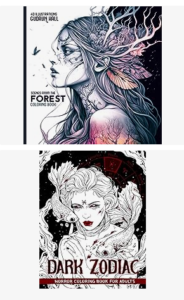Although this article is focused on KDP publisher, but most things discussed here can also be applied to any POD business. Let’s try to understand, how Kindle Direct Publishing KDP is being flooded with AI books!
In recent years KDP has seen an influx of line journal notebooks due to its ease of creation. With the introduction of AI art such as, Mid-Journey, CF Spark and others, it is expected that medium content or coloring books will also flood KDP, because of AI tools similar to notebooks.
By simply typing a phrase into a text prompt, such as dog sitting on a bench coloring page an AI can automatically generate an image based on the input. This makes it easy to create a coloring book by simply providing the text prompt.
While AI makes it easy to create individual coloring pages, it still takes time to create a full coloring book with at least 30 to 50 pages. This is in contrast to line journal notebooks, where only one design for the book cover is needed and the rest are simply repetitive lined pages.
Creating a coloring book with AI requires generating multiple unique images, whereas a line Journal notebook only requires one design.
What To Expect?
With the ease of creating coloring pages using AI art it’s likely that the market for coloring books on KDP will become more competitive.
The availability of AI tools such as Mid-Journey, which is considered one of the best in the market, makes it possible for anyone to start creating and publishing AI generated coloring books on KDP.
Pricing, Subscription And Other Corns
However, it’s important to keep in mind that the cost of using such tools can be a factor with some of them requiring a monthly subscription fee of up to thirty dollars for commercial use.
Additionally, using the cheaper ten dollars per month option make the AI generated art visible to the public, which could be a drawback for those looking to use it for commercial purposes.
Some Examples
I will provide two examples of AI generated books that are doing well on Kindle Direct Publishing with a high best seller rank.

Although I’m not certain, I suspect that some of these books may have been created using AI. As demonstrated by these books on KDP, AI generated content has surpassed the conventional methods of creating coloring books.
Traditional methods often require weeks or even months of effort, whereas AI allows for a much quicker and more efficient process these particular books are proof of how well AI generated content can perform in the market.
This shift towards AI generated books on KDP is rapidly changing the publishing landscape and presents both opportunities and challenges.
On one hand it’s now easier than ever to produce high quality coloring books and reach a wider audience. On the other hand the influx of AI generated content means that the market is becoming increasingly competitive, requiring publishers to stay on top of their game to stay relevant.
Nevertheless, the ease of creating coloring books with AI tools makes it a valuable investment for any publisher looking to streamline their production process. However, there are still some drawbacks to using AI-generated art for books on KDP.
Potentially Serious Concerns
Some artists are against the use of AI art and have even taken legal action against its use, claiming that their original artwork is being copied and used to generate AI art without their permission.
This can lead to some confusion and disagreement in the art world with some feeling that the use of AI takes away from the value of traditional hand-drawn art.
Impact On Traditional Art Community
In addition, the use of AI generated art also raises ethical concerns about the proper use of someone else’s work and the impact it may have on the livelihood of artists.
The publication of Alice and Sparkle by Ammaar Reshi has garnered significant attention in recent times with the author selling over 70 copies and earning 45 dollars within a single day of its release.
The news of the book’s success was shared on Twitter, resulting in an increase in sales, however, the publication also elicited criticism from the community of children’s writers and book illustrators.
The critics believe that Ammaar stole artwork from the artist using AI tools and did not put an adequate effort to earn payment for the book.
This has led to surprise and concern among the community about the potential of AI to perform tasks in the industry quickly.
AI tools have revolutionized the way books are created making it more uncomplicated and faster to generate high quality content. As a publisher on KDP, it’s essential to stay ahead of the curve and adopt these changes.
However, it’s important to also consider the potential consequences of using AI art such as artists filing lawsuits for an unauthorized use of their work to generate AI images.
It’s essential to strike a balance between utilizing the benefits of AI and respecting the rights of artists. Ultimately, it’s up to each publisher to weigh the pros and cons and make an informed decision about how they want to approach the use of AI in their publishing business.